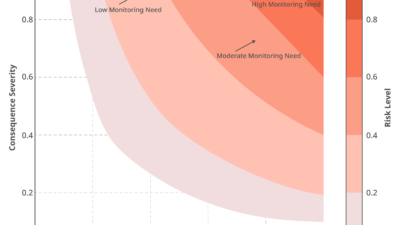By utilizing modern electrical power management systems (EPMS), organizations can go a step further to proactively access vital performance details including circuit loading, peak demand, and equipment status.

Today’s world-class facilities in the process industry are recognizing the value of near-perfect levels of reliability, as well as the resulting vast decreases in maintenance costs, revenue loss, and unplanned downtime.
New standards for reliability have been set as best-in-class plants are reaching upwards of 97% mechanical availability. Some time ago, these levels of performance were unprecedented.
By reducing scheduled and unscheduled downtime due to mechanical errors, companies can reduce maintenance costs by 50% or more, according to Solomon Associates, a benchmarking company that tracks industrial companies’ performance using reliability and maintenance metrics.
The truth is: you cannot manage what you do not know. Without real-time and historical data about power consumption, how can you identify inefficiencies or spot issues with electrical equipment before they result in failures? And, when improvements are implemented, how do you know if they are effective?
The critical purpose of an energy management program is to keep systems up and running and ensure power requirements are always met, by consolidating vast, real-time information on electrical systems across an entire facility.
However, by utilizing modern electrical power management systems (EPMS), organizations can go a step further to proactively access vital performance details including circuit loading, peak demand, and equipment status. Such systems also give organizations the ability to proactively set hundreds of alarms that warn building management of underperforming equipment and conditions threatening uptime.

Gateways and metering
Gateways enable quick access to the data monitored by meters and other devices, so that users and OEMs can see what is happening without having to log the data from the meter manually. Gateways are data acquisition devices that collect and consolidate that key data for real-time viewing and log historical data to generate reports.
Fundamentally, the gateway provides a way to collect electrical parameters and aggregate data from electrical equipment like meters, relays, and circuit breaker trip units into a system that can be monitored and managed. Further, gateways can also provide alarms and event status on communications, over- and under-voltage or current, and other available alarms from serial devices.
Reporting software can then aggregate data from multiple databases, providing a comprehensive solution for system-level management of the power infrastructure, to provide a complete enterprise-level view of energy usage, capacity utilization, and equipment performance.
When state-of-the-art metering and gateway solutions are combined with an EPMS with reporting features, a dashboard view across an entire enterprise is provided, along with the intelligence required to identify inefficiencies and target upgrades in a cost-efficient manner, while lowering operational costs and preventing equipment downtime in the process.
Harnessing the intelligence
Metering power consumption and capturing data across the enterprise, and making sense of it through software and reporting, provides information to understand the root cause of power problems. That information yields both short- and long-term returns.
However, it can be hard to change operational habits without understanding how power is being used in a process, facility, or enterprise. Once power and energy data are measured, making sense of that exhaustive data to identify vital statistics is crucial to identifying effective strategies to improve the efficiency and reliability of the facility by focusing on the most energy-hogging habits and implementing changes that save energy in the immediate and long term.
Finding effective ways to reduce energy usage starts with the knowledge of how it is being used today, and has been used in the past. Utilizing an EPMS with built-in reporting features, management can easily quantify and analyze energy consumption both to identify an effective energy management strategy and to validate if it is working.
Staying alert
Beyond helping facility managers identify wasteful energy habits, EPMS software can be used to establish notifications and alarms, to enable a fast response to power events and simplify troubleshooting.
By constantly collecting information, EPMS platforms make it possible to monitor the operation and status of all of the electrical components that are running in buildings, and trend measurements on those components over time looking for changes. When changes are detected, the information is used to investigate and respond proactively prior to service-impacting failures.
This troubleshooting process can be simplified through a wide variety of device alarms that can be managed from one central location. These alarms can be color-coded within an EPMS dashboard view for ease-of-use with rich sorting and filtering capabilities built in to simplify the analyzing of data. Alarms can also be acknowledged individually or by groups; sorted by date, priority, or device; and exported for further analysis. You can also dive deeper for additional analysis including viewing historical data around the time of the alarm occurrence.
EPMS solutions also ease the configuration of event notifications and alarms, enabling quick response to power events. Alarms with varying degrees of severity can be set through the software, which can then notify personnel when those parameters are met. Further, the software can be configured such that alarms are directed to the right people, depending on the time of day, shift, and other variables to ensure rapid response.
Planning for the future
Similar to preventing the downtime of today, planning the electrical usage and energy demands of tomorrow can be a difficult job. As site loads increase and usage patterns change, demand on a device may grow beyond its intended capacity. And, while average demand may not be a concern, peak demand always is, as even a momentary spike has the potential to bring down an entire network.
Today’s EPMS products track energy usage over time, immediately inform facility management of peak levels, and project future demands based on past usage. This knowledge is critical in planning for electrical upgrades, avoiding unnecessary expenditures, and making changes to the power chain to support load patterns.
The most recent advancements in EPMS systems even allow users to simulate electrical load increases, set capacity thresholds, and model potential system impacts prior to the addition of new electrical equipment to help reduce the risk of unplanned downtime and ensure adequate system protection.
Despite widely recognized benefits including simplified maintenance, reduced downtime, and enhanced efficiency, many of today’s industrial facilities do not properly monitor resource usage. Those that do often use outdated monitoring and management hardware and software platforms.
By installing or upgrading power and energy metering devices and EPMS, facility management can accurately manage, analyze, and trend electrical availability to set the proactive alarms needed to spot problems before they result in costly downtime, while easily identifying areas for energy efficiency improvement.
Marty Aaron is the product line manager at Eaton for software and connectivity products and has more than 25 years of experience in the electrical industry.



